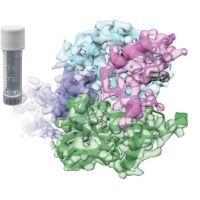Specification
| Organism | Homo sapiens (Human) |
| Expression Host | E.coli |
| Tag Info | N-terminal 10xHis-tagged and C-terminal Myc-tagged |
| Purity | Greater than 85% by SDS-PAGE |
| Uniprot ID | Q14669 |
| Gene Names | TRIP12 |
| Alternative Names | E3 ubiquitin-protein ligase for Arf (ULF) (HECT-type E3 ubiquitin transferase TRIP12) (Thyroid receptor-interacting protein 12) (TR-interacting protein 12) (TRIP-12) |
| Expression Region | Partial(1881-1992aa ) |
| Molecular Weight | 19.9 kDa |
| Protein Sequence | ECCRPDHGYTHDSRAVKFLFEILSSFDNEQQRLFLQFVTGSPRLPVGGFRSLNPPLTIVRKTFESTENPDDFLPSVMTCVNYLKLPDYSSIEIMREKLLIAAREGQQSFHLS |
| Form | Liquid or Lyophilization |
| Buffer | The default storage buffer is Tris/PBS-based buffer, 5%-50% glycerol if the delivery form is liquid. The lyophilization buffer is Tris/PBS-based buffer, 6% Trehalose, pH 8.0 if the delivery form is lyophilized powder. Please contact us if you have any special requirment. |
| Reconstitution | Please reconstitute protein in deionized sterile water and we recommend that briefly centrifuge thevial prior to opening the vial .We recommend aliquot for long-term storage at -20℃/-80℃. |
Background
| Relevance | E3 ubiquitin-protein ligase involved in ubiquitin fusion degradation (UFD) pathway and regulation of DNA repair. Part of the ubiquitin fusion degradation (UFD) pathway, a process that mediates ubiquitination of protein at their N-terminus, regardeless of the presence of lysine residues in target proteins. In normal cells, mediates ubiquitination and degradation of isoform p19ARF/ARF of CDKN2A, a lysine-less tumor suppressor required for p53/TP53 activation under oncogenic stress. In cancer cells, however, isoform p19ARF/ARF and TRIP12 are located in different cell compartments, preventing isoform p19ARF/ARF ubiquitination and degradation. Does not mediate ubiquitination of isoform p16-INK4a of CDKN2A. Also catalyzes ubiquitination of NAE1 and SMARCE1, leading to their degradation. Ubiquitination and degradation of target proteins is regulated by interaction with proteins such as MYC, TRADD or SMARCC1, which disrupt the interaction between TRIP12 and target proteins. Acts as a key regulator of DNA damage response by acting as a suppressor of RNF168, an E3 ubiquitin-protein ligase that promotes accumulation of 'Lys-63'-linked histone H2A and H2AX at DNA damage sites, thereby acting as a guard against excessive spreading of ubiquitinated chromatin at damaged chromosomes. |
| Involvement in Disease | |
| Subcellular Location | Nucleus, nucleoplasm |
| Protein Families | UPL family, K-HECT subfamily |
| Tissue Specificity | TRIP12 |
QC Data
| Note | Please contact us for QC Data |
| Product Image (Reference Only) |  |

